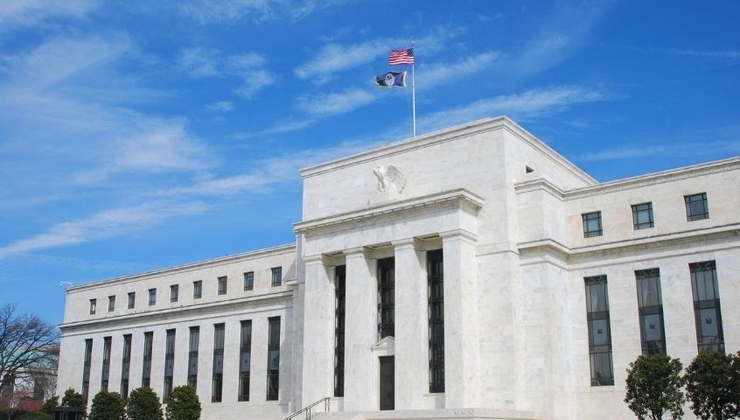CFDs are complex instruments and come with a high risk of losing money rapidly due to leverage. 72.2% of retail investor accounts lose money when trading CFDs with this provider. You should consider whether you understand how CFDs work and whether you can afford to take the high risk of losing your money.
- English
- Italiano
- Español
- Français
US election: Why a blue wave may be the USD’s most bullish case

Ultimately we have four possible election day outcomes: a red redux, a blue wave, a divided government, or a contested/delayed result. We’ve seen recently how problematic a divided government can be, with house democrats and republicans unable to agree on a fiscal relief package. Ultimately a government with full control of Congress is the bull case for markets and a blue wave may be even more bullish than republican control - as the democrats have made it clear they are willing to blow the deficit and spend big.
So six weeks out from the election, how are markets positioned? We have the US dollar index (USDX) at a two-year low, mostly due to an ever-dovish Federal Reserve, but it’s a trend that could continue into the election. Gold (XAUUSD) has consolidated between 1920 and 1980 after setting a series of record highs in August. The precious metal is moving sideways, waiting for a trigger to break out of the range. US stocks are strong despite last week’s rotation out of tech and US treasury yields remain low, with real rates slowly pushing deeper into negatives.
Quite possibly the most important forex pair to watch as the election nears is USDJPY. The forex pair has a track record of sensitivity to US elections, typically falling in the lead up on safe haven flows and risk hedging, then unwinding once the dust settles. Start forex trading today.
On the weekly chart, we find price in a descending channel that’s so far held for 14 weeks. The steady fall reflects broader USD weakness but also supports the trend of JPY strength ahead of election day. The USD may also simply struggle to find buyers until an election outcome is known. So if the USDJPY bear channel holds as the election approaches, it may be the newsflow on election day that provides the catalyst for a break higher or lower.
Weekly chart: USDJPY. Support at 105.30. Chart source data: Metaquotes MT5.
Nearer term, I’m watching for a break of 105.30 support on a closing basis to encourage the next move lower, with a target near 104.22 - still within the descending channel.
S&P 500 - Do US stocks hold the clue?
US stocks have defied odds and erased pandemic losses. The NAS100 started setting new record highs in June; and the S&P 500 (US500) in August.
There’s a reason Trump emphasises the NAS and the S&P time and time again: a positive stock market is typically good news for the incumbent. In fact, 90% of the time since 1928, the incumbent has won a second term when the US500 has been positive three months out from the election. The president has gone as far as pushing the idea that a democratic administration would hurt the stock market, and although there’s no real reason to justify that, it shows Trump’s awareness the stock market can be an election winner.
Daily chart: US500. Chart source data: Metaquotes MT5.
Despite the recent tech sell-off and rotation into underperforming stocks, the US500 remains strong and has so far found support in the 50-EMA (purple line). Yet price is struggling to push back above that 3400 handle, which represents the pre-pandemic highs. If stocks start to sour - a daily close below the 50-EMA would concern me - so too could Trump’s re-election odds.
So are we looking at an eventual re-test of the Feb-Sep trendline (black)? Or is this the start of something sinister? I’ll let the technicals play out before I take a view on this one.
Election scenarios
Strong US stocks and a weak US dollar, for now at least. So how could the possible US election outcomes move these markets?
Trump and a red redux
Cast your mind back to 2016 and markets were nervous about what a Trump presidency would mean for markets. They quickly found their mojo again though when Trump started sounding “presidential” and his pro-business stance was better understood.
A Trump win in November, with a majority in Congress, is a pretty bullish case for markets. It’s the status quo ticket as markets know what to expect - and US-China trade war aside, Trumpian policy has been accommodative for business and markets.
But as business-friendly as the administration has been, what markets really need is growth in order to climb out of the covid recession. While the 2017 corporate tax cuts were mostly deficit financed and fiscal support this year record in size, house republicans are not as willing to spend as big as democrats are.
Polls also suggest a red wave is unlikely. While Trump could win the White House again, the democrats will likely maintain their house majority, which will cause headaches for new legislation and recovery packages.
Biden and a blue wave
Contrary to conventional beliefs, a blue wave may just be the most bullish case for the USD and US stocks this election. Sure the Democratic party is generally perceived as less friendly to Wall Street and Biden has talked about a corporate tax hike, but markets are less punishing of currencies whose governments run ever-larger deficits these days - and the democrats are ready to spend big.
The Biden-Harris ticket has proposed a $2tn infrastructure package, mostly deficit financed, and recent house negotiations show the democrats willing to spend larger than the GOP. The Fed can’t drive higher inflation by itself, and central banks the world over have emphasised the need for fiscal spending to lead the recovery, so the 2020 democratic ticket may just be the bullish case for growth and US outperformance.
The infrastructure spend would create jobs, support business, and hopefully create upward pressure on wages and prices. While energy and financial stocks may struggle under Dem policies, a strong case for growth would boost the consumer staples and discretionaries sectors. And as US economics start to outperform the rest of the world, capital starts flowing into the US, boosting the USD and US stocks.
If the outcome on 3 November is an uncontestable blue wave, we may still see that typical market panic, however I’d expect it to be short-lived and see a buying opportunity.
Divided government
The US government is currently divided, with a republican White House and democratic house. We’ve recently seen the stalemates such a setup can cause when trying to pass crucial fiscal packages.
Under a divided government, less can be achieved and crisis responses can slow - this is particularly worrying when trying to climb out of an economic crisis as we are now.
So while a mixed administration could prevent a Biden administration lifting the corporate tax rate and cracking down on the fossil fuel industry, it could prevent stimulus packages and hinder the recovery, hurting the USD and US stock markets with stimulus plans less likely to be rolled out.
Contested election
Trump has sown the seeds of mail-in voter fraud or a rigged election, hinting that he may not give up power so easily if the results are close. Slower counting of mail-in votes may also see Republicans claiming victory on early results before mail-in votes tilt the outcome blue. This is all a recipe for market volatility.
Whether the result is delayed due to the expected uptake in mail-in ballots, or outright contested because the results are close, the outlook becomes much less certain. Recent civil unrest also suggests that certain results could face mass protests.
There’s a lot to consider ahead of 3 November, and a lot could change in the few weeks left ahead of election day. So how will you trade the 2020 US election?
Related articles
Ready to trade?
It's quick and easy to get started. Apply in minutes with our simple application process.
The material provided here has not been prepared in accordance with legal requirements designed to promote the independence of investment research and as such is considered to be a marketing communication. Whilst it is not subject to any prohibition on dealing ahead of the dissemination of investment research we will not seek to take any advantage before providing it to our clients. Pepperstone doesn’t represent that the material provided here is accurate, current or complete, and therefore shouldn’t be relied upon as such. The information, whether from a third party or not, isn’t to be considered as a recommendation; or an offer to buy or sell; or the solicitation of an offer to buy or sell any security, financial product or instrument; or to participate in any particular trading strategy. It does not take into account readers’ financial situation or investment objectives. We advise any readers of this content to seek their own advice. Without the approval of Pepperstone, reproduction or redistribution of this information isn’t permitted.

